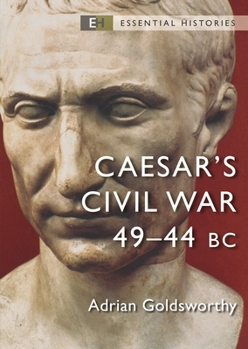Caesar's Civil War: 49-44 BC
(Book #42 in the Osprey Essential Histories Series)
Select Format
Select Condition 
Book Overview
Fully illustrated with colour maps and images, this is an accessible introduction to Julius Caesar's Civil War.
Format:Paperback
Language:English
ISBN:1472855078
ISBN13:9781472855077
Release Date:January 2023
Publisher:Osprey Publishing (UK)
Length:144 Pages
Weight:0.65 lbs.
Dimensions:0.4" x 6.1" x 7.9"
Customer Reviews
2 ratings
A Complex War Made Simple
Published by Thriftbooks.com User , 16 years ago
Adrian Goldsworthy did an excellent job of condensing the battles, campaigns, and political drivers of the Roman Civil War. This book is focused, well organized, and follows the standard format of the Essential Histories series. It has ten chapters and the softcopy edition is 92 pages long. The book contains numerous photos of ancient coins, helmets, statues, and scenes carved on monuments. The photos are of good quality and make a worthwhile contribution. The author also included battle maps that are clean, simple, and give just the right amount of information. The chapter on "The fighting" is divided into sections that focus on certain campaigns and their associated years. In this way, the chapter provides an excellent overview of the more critical battles such as the Ilerda Campaign, Pharsalus, Thapsus, and Munda. Certain sections are subdivided even further. For example, the campaign in Greece is spit to cover the battle at Dyrrachium and then the battle of Pharsalus. The narrative then boils down each battle to its relevant parts. The chapter titled "Portrait of a Civilian" focuses on Cicero, the well-known Roman senator. Although Cicero's involvement in the Civil War was minimal, his writings provide excellent insight on the Senate's view of the war. Cicero wanted peace and only reluctantly sided with Pompey. He was later killed because of his opposition to Mark Antony. Cicero derisively described how the senators in Pompey's camp became arrogant in their anticipation of winning the war. Caesar's victory at Pharsalus only reinforced Cicero's low opinion of the Pompeian forces. The book contains a chapter on Roman centurions. Mr. Goldsworthy does a fine job of describing their activities even though very little first hand information is available. He effectively uses the few known examples of specific individuals to paint a picture of their contributions to the Roman legions. The book ends with a chapter on "Conclusions and Consequences." This chapter provides a short synopsis of the Civil War's aftermath and the end of the Republic. The author describes the upcoming alliance and subsequent falling out between Mark Antony and Caesars' adopted son, Octavian. He goes on to describe the second triumvirate, the proscriptions that led to Cicero's death, and the Battle of Actium where Octavian defeated Mark Antony and Cleopatra. In essence, the author provides a nice conclusion to the Civil War and shows how Octavian, a.k.a.: Augustus, became the first Roman emperor. Bottom line: this is a well-organized and comprehensive book on the Civil War. It is an easy read and one of the better volumes in the Essential Histories series.
Caesar versus Pompey
Published by Thriftbooks.com User , 21 years ago
Osprey's Essential History #42, Caesar's Civil War 49-44 BC, is a fine summary of the climactic struggle that began to mark Rome's slide from Republic to monarchy. Adrian Goldsworthy, an English scholar of the Roman military, uses Caesar's own commentaries and Appian's later history as the basis for this account. In fact, this volume is probably Goldsworthy's best effort to date. Overall, this is easily the best summary of Caesar's struggle for supreme power available. Caesar's Civil War 49-44 BC begins with a short introduction on the Roman Republic, a chronology, a section on the background to the war (the First Triumvirate) and a 6-page section on the opposing sides. The main narrative is 37 pages and covers operations between Caesar's crossing of the Rubicon River and the Battle of Munda. Final sections include portrait of a soldier (Caesar's centurions), the development of the dictatorship, portrait of a civilian (Cicero), Caesar's assassination, and the end of the Republic (which covers the final struggle between Antony and Octavian). One interesting addition is a 2-page glossary that provides thumbnail biographies of all the key characters. There are a total of seven maps in this volume: the Roman world in 50 BC, Caesar's advance through Italy, the Ilerda campaign, the Battles of Dyrrachium, Pharsalus, Thapsus and Munda. Given the extent of operations during the civil wars, the maps are not quite sufficient to follow operations in a number of areas, including Spain, Syria, Greece and Africa. Military readers will be interested by Goldsworthy's discussion of the changing role of the Roman military and its relationship to the outbreak of civil war. By the 1st Century BC, the Roman Army had been transformed from the part-time citizen militia into a standing force. However, Goldsworthy writes that, "the senate refused to acknowledge this change, maintaining that military service was a duty requiring no formal reward, and made no provision to provide for discharged soldiers." Instead, "soldiers started to become more loyal to generals who offered such rewards than to the republic which neglected them. The rise of the professional army was probably the most important of the problems besetting the Republic with which the Senate failed to deal..." After the civil war ended, the victorious Augustus acted to remedy these defects by standardizing military pay and terms of service, as well as providing a guaranteed pension for discharged veterans. Goldsworthy concludes that, "Augustus took care that the legionaries' loyalty was focused on him and no one else. The men were paid by the emperor, swore an oath of loyalty to him and ...received medals from him." It is clear that the author is sympathetic to Caesar's motives in precipitating a five year long civil war. Certainly Caesar had ample reason to fear that his political rivals would engineer his demise once he laid down the governorship and returned to private life.





